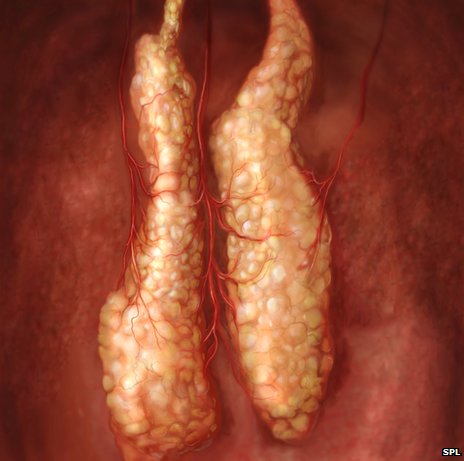A whole functional organ has been grown from scratch inside an animal for the first time, say researchers in Scotland. A group of cells developed into a thymus – a critical part of the immune system – when transplanted into mice.
The findings, published in Nature Cell Biology, could pave the way to alternatives to organ transplantation. Experts said the research was promising, but still years away from human therapies. The thymus is found near the heart and produces a component of the immune system, called T-cells, which fight infection.
Grow your own
Scientists at the Medical Research Council centre for regenerative medicine at the University of Edinburgh started with cells from a mouse embryo. These cells were genetically “reprogrammed” and started to transform into a type of cell found in the thymus. These were mixed with other support-role cells and placed inside mice.
Once inside, the bunch of cells developed into a functional thymus. It is similar to a feat last year, when lab-grown human brains reached the same level of development as a nine-week-old foetus.
The thymus is a much simpler organ and in these experiments became fully functional. Structurally it contained the two main regions – the cortex and medulla – and it also produced T-cells. Prof Clare Blackburn, part of the research team, said it was “tremendously exciting” when the team realised what they had achieved.
She told : “This was a complete surprise to us, that we were really being able to generate a fully functional and fully organised organ starting with reprogrammed cells in really a very straightforward way. “This is a very exciting advance and it’s also very tantalising in terms of the wider field of regenerative medicine.”
Patients who need a bone marrow transplant and children who are born without a functioning thymus could all benefit. Ways of boosting the thymus could also help elderly people. The organ shrinks with age and leads to a weaker immune system. However, there are a number of obstacles to overcome before this research moves from animal studies to hospital therapies.
The current technique uses embryos. This means the developing thymus would not be a tissue match for the patient. Researchers also need to be sure that the transplant cells do not pose a cancer risk by growing uncontrollably.
Prof Robin Lovell-Badge, from the National Institute for Medical Research, said: “This appears to be an excellent study. “This is an important achievement both for demonstrating how to make an organ, albeit a relatively simple one, and because of the critical role of the thymus in developing a proper functioning immune system.
“However… the methods are unlikely to be easy to translate to human patients.” The field of regenerative medicine has developed rapidly. There are already patients with lab-grown blood vessels, windpipes and bladders. These have been made by “seeding” a patient’s cells into a scaffold which is then implanted.
The thymus just required an injection of cells. Dr Paolo de Coppi, who pioneers regenerative therapies at Great Ormond Street Hospital, said: “Research such as this demonstrates that organ engineering could, in the future, be a substitute for transplantation.
“Engineering of relatively simple organs has already been adopted for a small number of patients and it is possible that within the next five years more complex organs will be engineered for patients using specialised cells derived from stem cells in a similar way as outlined in this paper.
“It remains to be seen whether, in the long term, cells generated using direct reprogramming will be able to maintain their specialised form and avoid problems such as tumour formation.”
Source; bbc


